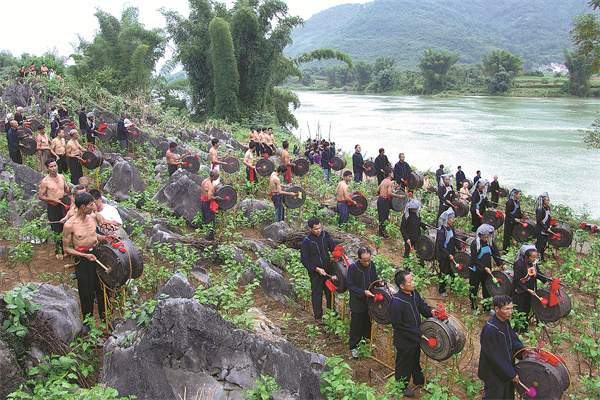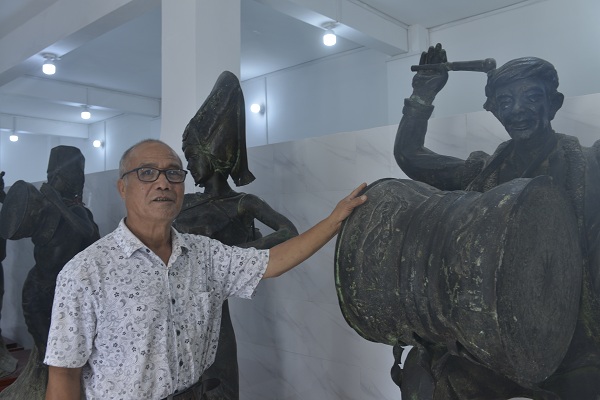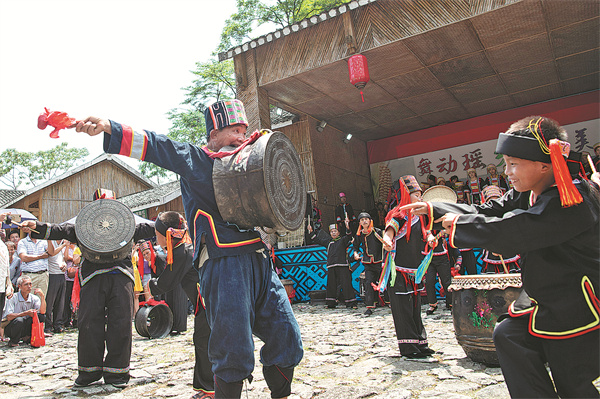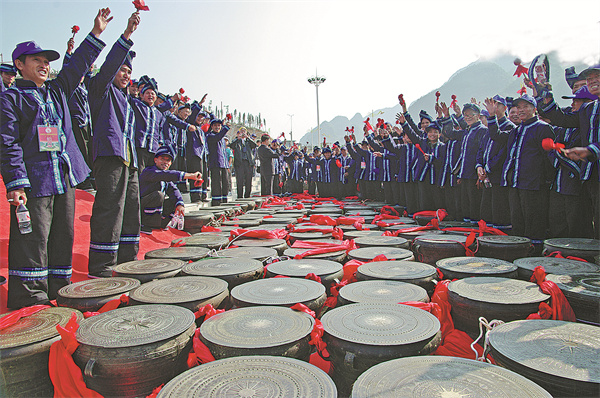Bronze drums and the man

Bronze drums play an important role in local people's lives, religions and culture in Donglan county, Guangxi Zhuang autonomous region.[Photo provided by Li Tong/For China Daily]
When he was 13, sometime in the early '70s, Chen Yaoling fell into the Honghe River near his home in Donglan county of Guangxi Zhuang autonomous region three times that year.
Although Chen didn't know how to swim, he managed to save himself every time. A fortuneteller attributed his good luck to the name of the section of the river bank he fell in - "bronze drum bank".
But Chen believes his life was linked to bronze drums anyway.
On the left bank of the Latong Bridge in Donglan county today stands a traditional style building that is China's first private bronze drum museum. Visitors to the Donglan Bronze Drum Museum also get an insight into the unusual life of its owner, Chen, whose fate is deeply linked with this artifact that plays an important role in religion, traditions and life itself. In fact, the time he fell into the river wasn't his only brush with the bronze drum.

Chen Yaoling, a collector of bronze drums and a TCM doctor, exams various drums in his museum in Donglan.[Photo provided by Li Tong/For China Daily]
Chen's father was a well-known traditional Chinese medicine doctor. Chen picked up the skill from his father and treated local farmers himself. One day in 1974, he treated a married woman who was unable to conceive. The farmer's family offered him the gift of an ox in gratitude, but Chen declined the gift saying it was too expensive. He settled instead for an old bronze drum that the family gave him. That was to be the first piece in his bronze drum collection.
Since then Chen has collected more than 100 bronze drums, laying the groundwork for his museum.
During the "cultural revolution"(1966-76), bronze drums were regarded as remnants of a backward society and were being confiscated to be destroyed.Those who owned one were only too happy to hand over the "troublemakers" to Chen.
To avoid falling in trouble because of his strange hobby, Chen would wait until dark before returning home with his new possessions.

The Zhuang people in Hecheng, Guangxi Zhuang autonomous region, beat bronze drums to celebrate their traditional festivals. The ceremony has evolved into a tourist attraction in the region. [Photo provided by Ma Fangkang/For China Daily]
Since the end of the "cultural revolution", Chen has been collecting bronze drums and working as a TCM doctor in his county. He now has the largest personal collection of bronze drums belonging to the Zhuang people.
The history of bronze drums in Guangxi can be traced back 2,000 years.At present, there are a little more than 2,000 bronze drums of the Zhuang people in museums around the world, of which 612 are in Donglan, which is the largest collection anywhere.
"Bronze drums integrate smelting,casting, sculpture, painting, decoration, music, dance and religion," said Chen. "It is a national cultural heritage integrating cultural diversity and uniqueness."
Collecting, protecting, dancing with and holding bronze drum competitions are now popular in Donglan today. Not only has the tool that was once seen as a symbol of backwardness reclaimed its status in the Zhuang people's social life,traditions and religion, but also the "living fossil" of the Zhuang people has become an important tourist attraction that is reviving the cultural industry there.
The bronze drum has been handed down from generation to generation,but few people know its history. Chen has tried to catalogue the stories associated with each bronze drum he collected. Every time he received a bronze drum, he asked the owner what was unique about its shape, the significance of its design, what legend the pattern represented and more.
Each bronze drum has its unique design and patterns that are related to folk legends, myths and traditions of the Zhuang people. As Chen puts it,each drum has a "soul".

The Zhuang people in Hecheng, Guangxi Zhuang autonomous region, beat bronze drums to celebrate their traditional festivals. The ceremony has evolved into a tourist attraction in the region. [Photo provided by Ma Fangkang/For China Daily]
Having regained their social standing, bronze drums are suddenly hot property. Many have approached Chen with a good offer for his drums - he can easily make millions of yuan each year by simply renting the drums for exhibition - but he is not yielding. For him,each drum is a "non-renewable resource". He fears that should he rent out the drums, "it might become difficult to get them back".
Ten years ago, Chen borrowed about 5 million yuan ($712,771) to build a museum to popularize the Zhuang people's cultural treasure. The museum now showcases more than 100 bronze drums in different halls according to their different usage.
Unlike other museums, visitors to Chen's museum are allowed to touch the exhibits, even beat some of the drums. "Let people have a zero-distance contact with the bronze drums. It will arouse their interest and draw more people to protect the drums. This is how the legacy of the bronze drum culture will survive," Chen said.
In 2006, the central authorities listed the Zhuang bronze drum custom in Hechi as one of the first national intangible cultural heritages. Donglan was recognized as the hometown for national folk bronze drum arts. The county is now paying special attention to developing tourism and the cultural industry related to bronze drums.
